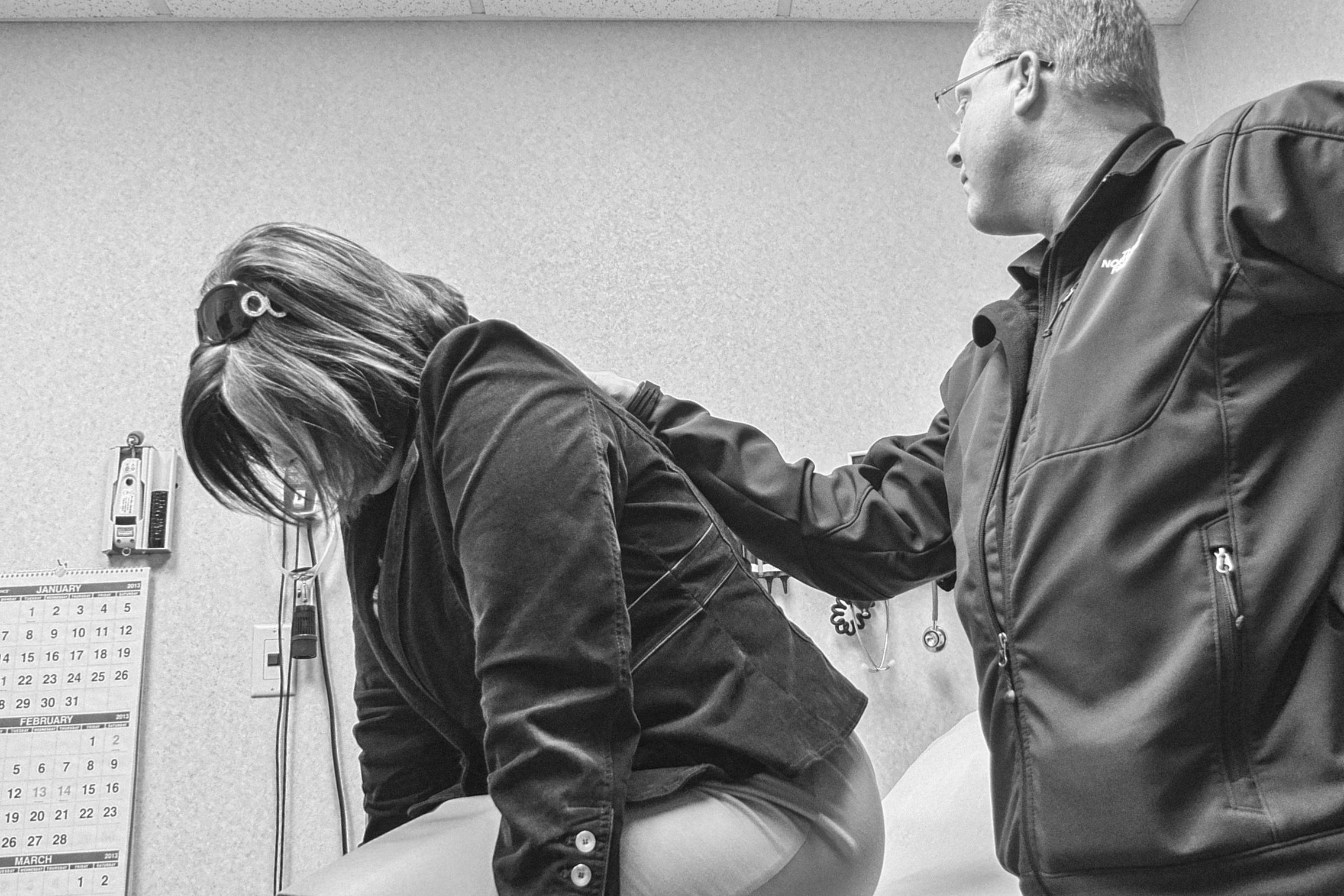Steps To Take After You Get A Breast Cancer Diagnosis
In January 2013, I was contacted by a photographer who had been diagnosed with breast cancer. Debbie Gibb and her husband, Mike, asked me to capture their journey through photos.
At this point all of my breast cancer photography and advocacy work had been with women who had already finished treatment. Now, I had the opportunity to see what cancer treatment looked like up close. Though it may have appeared strange to some to have a man with large camera tagging along to all of Debbie’s appointments, she usually explained to people that she wanted photos for her own projects after recovery.
What I learned over the next 18 months changed the way I view patient rights and advocacy. I have met some wonderful, talented and caring doctors, nurses, surgeons, therapists and social workers in our hospital systems. I have also experienced, with Debbie and several other breast cancer patients, how some areas of patient care can easily fall through the cracks.
Before surgery
Debbie’s first request was that I take some “before” photos of her breasts. It was just before her scheduled double mastectomy. She sat down with my wife, Jamie, and me and told us about her feelings of losing her breasts as well as her gratitude that they had served their purposes well. Her husband joined us after work and we started the photo session. What we captured was intimate and special. This set of photos brings up a lot of emotions for Debbie, yet that is why she wanted them taken.
I’ve had over a dozen breast cancer patients tell me that they wish they had taken professional portraits of their breasts before their surgeries but no one ever encouraged them to do so. There are many important decisions to make once breast cancer has been diagnosed, and there is also the necessary pressure to start treatment as soon as possible. Since these portraits fill an emotional need instead of taking care of a medical one, the conversation doesn’t come up. This is an item that should be included on a patient’s treatment checklist, especially since a woman will not be able to capture the portrait later.
When Debbie had healed from her bilateral mastectomy, she made an appointment to be fitted for prosthetics and a bra. The technician explained to us that if a patient sets up an appointment before her mastectomy they can make a cast of her breasts and create prosthetics to fit her own bras and clothes. While losing your breasts is a monumental loss, the added emotional letdown a woman experiences when none of her clothes fit after surgery may not be necessary. These types of prosthetics are usually covered by most health insurance policies, but most breast cancer patients aren’t informed that they even have this option.
nurse navigators
Breast cancer treatment doesn’t come from just one doctor, but a group of them. Many patients will have their own OB/GYN, and three oncologists — one that performs surgeries, one that oversees radiation treatments and one that oversees chemotherapy and other medications. These doctors will also send patients out for various scans, biopsies, blood work and genetic testing. Patient care may also include visits with social workers, nutritionists, wound technicians and physical therapy. Trying to locate, schedule and coordinate all of this care can be difficult and stressful. This is where a nurse navigator steps in.
A nurse navigator is typically a registered nurse who has specialized training in oncology. They are employed by hospitals and will guide a patient through this maze of appointments. This important role in the hospital system is designed to:
• Assist newly diagnosed breast cancer patients.
• Act as a liaison between the treatment providers and the breast cancer patient.
• Provide information with online resources, printed material and in-hospital education about cancer.
• Answer treatment questions for both the patient and the family members.
• Help facilitate the scheduling of appointments.
A nurse navigator, or other professional in a hospital, should also provide the following support:
• Help arrange transportation to and from appointments and treatments.
• Arrange translation or interpretation services when needed.
• Provide organized copies of the patient’s paperwork.
• Work with the patient regarding financial services and insurance support.
• Provide information about available clinical trials.
• Help create a care plan for after treatment wellness.
For some patients, the desire for second opinions, different surgery options or information about care that your hospital doesn’t provide will not be facilitated by your hospital’s nurse navigator. Typically hospitals do not want to refer you outside of their system or care network. It may be in your best interest to research other options than what your hospital can provide. I have several friends who have traveled to out-of-state hospitals in order to obtain a specific type of surgery or reconstruction procedure.
Patient navigators
The local chapter of American Cancer Society in Boise, for instance, employs patient navigators who can help connect cancer patients to programs that help provide lodging for those who have to travel from rural areas for their treatment, provide rides, connect patients to someone else who has been down a similar diagnosis and treatment regimen and more.
Additional support for breast cancer patients can be found on the websites of numerous national cancer organizations like Susan G. Komen (ww5.komen.org/BreastCancer/AboutBreastCancer.html) and Livestrong (www.livestrong.com/sscat/breast-cancer). The American Cancer Society (ACS) has a very helpful list of treatment tools and support topics on its website www.cancer.org/treatment/index.
Many communities have local chapters of these organizations as well as independent organizations. In Boise, The Cancer Connection Idaho provides a wide range of support and classes to cancer patients, their families and caregivers ( cancerconnectionidaho.org).
care advocates
While the guidance of a nurse navigator and the resources of a patient navigator are invaluable, some of the most important assistance comes from a breast-cancer patient’s own care advocate.
This can be a family member or a friend that the patient trusts as well as can commit to the time. Sometimes family members and close friends can be too emotionally involved to be the best advocate in this setting, which may mean adding an additional person to the patient’s care team. After her surgery, Debbie met with her medical oncologist to find out what stage and type of cancer she had.
Her follow-up care, potential need for chemotherapy, radiation treatments, and participation in a clinical trial were all on the agenda to discuss with her doctor. Both Debbie and Mike were obviously scared.
The doctor arrived with loads of information, most of which was positive, with several important treatment options for Debbie to consider. After the appointment, Debbie and Mike were reviewing the discussion as they both focused on different parts of the doctor’s input. They asked me what I remembered.
I held up my digital recorder and told them they could listen to the doctor’s discussion all over again. When they asked me why I thought to record the conversation, I told them it was because in their emotional state, I figured they might need to go over it again. They were grateful. This wasn’t the last doctor’s appointment that I’ve recorded. I do, however, get permission from the doctor to do so. I’ve never been turned down.
And in my opinion, there should always be at least one care advocate at a cancer patient’s appointments and treatments.
Patient rights
In my experience, all doctors’ offices have been fully supportive of having a care advocate present with a patient. I’ve not always seen that same consideration in some of the diagnostic/treatment facilities. At one point Debbie needed a biopsy of a new lump that she had found. Both Mike and I went to support her. After Debbie had been prepped for the procedure, a nurse came to the waiting room door and said that one of us could come back. Mike joined her.
Two minutes later the nurse returned, although obviously not happy about it, “Apparently you are coming back, too…”
I have also been told I could not come beyond the waiting room for a friend’s procedure because I was male.
Being banned from having your chosen care advocate present because of gender is unnecessary and unprofessional. It should not be up to a clinic to determine who an appropriate care advocate should be for that patient.
Other facilities have used the excuse of following the Health Protection and Promotion Act (HIPPA) as a way to limit access.
The point of the law is not to protect the hospital or facility, it is for the privacy and protection of the patient. There are forms that can be quickly filled out by the patient so their chosen care advocate can have access to their information.
Debbie is one of the strongest women I’ve encountered. She knew what she needed during her fight with breast cancer and spoke up on many occasions to make her voice and wishes heard. Now she is an an advocate for other women going through a similar journey. Debbie maintains a blog on survivorship wellness that can be found at www.facebook.com/SurvivorshipWellness.
PRACTICAL TIPS
- If you want before-surgery photos you have several options — you can ask a professional photographer (some donate this type of work), you can ask a friend or family member you feel secure with, or you can even take selfies with your own camera/phone. Just be careful where the images are stored.
- Make an appointment with a prosthesis/bra shop before your mastectomy to discover what services are available for you and what is covered by insurance.
- Find out exactly what duties the nurse navigator from your hospital will be responsible for and take advantage of their specialized care. If there are areas that your nurse navigator is not expected to provide, find out if someone else in the hospital system will provide it or if you need to look outside for additional support.
- Research if it will be more beneficial to stay in one hospital’s comprehensive care network from diagnosis to aftercare wellness, (they may be able to consolidate billing, facilitate communication between their professional caregivers, and expedite appointments), or if you need the freedom to seek care out of their network.
- Contact local cancer agencies to find what support is available in your community both during and after your treatments.
- Choose at least one family member or friend who can serve as a care advocate. Never go to an appointment alone. Ask your doctor if you can record important discussions.
- Know your patient rights and stand up for them. Do not let an inconvenienced staff member or a facilities “policy” dictate what your best care will be. Remember you have hired them, not the other way around.



